Peanut Drought Risk Zoning in Shandong Province, China
Abstract
:1. Introduction
2. Materials and Methodology
2.1. Study Area
2.2. Data Sets
2.3. Methods
2.3.1. Basic Theory of Disaster Risk Assessment
2.3.2. Weighted Comprehensive Evaluation Method
2.3.3. Analytic Hierarchy Process
2.3.4. Standardization
2.3.5. Arc-GIS Spatial Analysis
2.3.6. Drought Classification
3. Results
3.1. Spatial Distribution of Peanut Drought Risk
3.1.1. Meteorological Factor Risk Zoning
3.1.2. Zoning of Disaster Environment Sensitivity
3.1.3. Drought Risk Zoning for Peanuts in Shandong Province
3.2. Spatial Distribution of Exposure of Peanut-Drought-Affected Bodies
3.3. Spatial Distribution of Vulnerability of Peanut-Drought-Bearing Bodies
3.4. Spatial Distribution of Disaster Prevention and Mitigation Capability
3.5. Spatial Distribution of Comprehensive Peanut Drought Risk
4. Discussion
5. Conclusions
Author Contributions
Funding
Institutional Review Board Statement
Informed Consent Statement
Data Availability Statement
Conflicts of Interest
References
- Sarkar, T.; Thankappan, R.; Kumar, A.; Mishra, G.P.; Dobaria, J.R. Stress inducible expression of AtDREB1A transcription factor in transgenic peanut (Arachis hypogaea L.) conferred tolerance to soil-moisture deficit stress. Front. Plant Sci. 2016, 7, 935. [Google Scholar] [CrossRef] [Green Version]
- Tang, S.; Yu, S.L.; Liao, B.S.; Zhang, X.Y.; Sun, H.Y. Industry Status Existing Problems and Development Strategy of Peanut in China. J. Peanut Sci. 2010, 39, 3538. (In Chinese) [Google Scholar] [CrossRef]
- Subrahmanyam, P.; Reddy, L.J.; Gibbons, R.W.; McDonald, D. Peanut Rust: A Major Threat to Peanut Production in the Semiarid Tropics. Plant Dis. 1985, 69, 813–819. [Google Scholar] [CrossRef]
- Miao, H.C.; Li, Q.; Hou, X.F.; Jia, D.H.; Shi, B.X.; Ding, H.; Li, L.M.; Zhang, Z.M. Effects of Drought at Different Growth Stages on Growth and Yield of Peanut. Xinjiang Agric. Sci. 2021, 58, 441–449. (In Chinese) [Google Scholar] [CrossRef]
- Wang, X.; Li, Y.; Zhu, H.; Chi, X.Y.; Wu, L.R.; Zhao, L.G.; Wang, J.S.; Yu, S.L. Directional Screening on Peanut Mutant with High Oil Content and Correlation between Oil Content and Leaf Water Potential. J. Qingdao Agric. Univ. 2019, 36, 30–33. (In Chinese) [Google Scholar] [CrossRef]
- Jiang, H.F.; Ren, X.P. The Effect on SOD Activity and Protein Content in Groundnut Leaves by Drought Stress. Acta Agron. Sin. 2004, 30, 169–174. (In Chinese) [Google Scholar]
- Girdthai, T.; Jogloy, S.; Vorasoot, N.; Akkasaeng, C.; Wongkaew, S.; Holbrook, C.C.; Patanothai, A. Heritability of, and Genotypic Correlations between, Aflatoxin Traits and Physiological Traits for Drought Tolerance under End of Season Drought in Peanut (Arachis hypogaea L.). Field Crops Res. 2010, 118, 169–176. [Google Scholar] [CrossRef]
- Jongrungklang, N.; Toomsan, B.; Vorasoot, N.; Jogloy, S.; Boote, K.J.; Hoogenboom, G.; Patanothai, A. Drought Tolerance Mechanisms for Yield Responses to Pre-flowering Drought Stress of Peanut Genotypes with Different Drought Tolerant Levels. Field Crops Res. 2013, 144, 34–42. [Google Scholar] [CrossRef]
- Wan, S.B.; Wang, C.B.; Zhu, J.H. Advantages, Problems and Countermeasures of Peanut Industry in Shandong Province. Shandong Agric. Sci. 2004, 5, 5–8. (In Chinese) [Google Scholar] [CrossRef]
- Liao, B.S. A Review on Progress and Prospects of Peanut Industry in China. Chin. J. Oil Crop Sci. 2020, 42, 161–166. (In Chinese) [Google Scholar] [CrossRef]
- Li, Z.D. Study on the Pricing of Peanut Drought Index Insurance in Shandong Province. Ph.D. Thesis, Guizhou University of Finance and Economics, Guiyang, China, 2016. (In Chinese). [Google Scholar]
- Zhang, J.Q.; Liang, J.D.; Zhou, D.W. Risk Assessment of Ecological Disasters in Jilin Province Based on GIS. Chin. J. Appl. Ecol. 2007, 18, 1765–1770. (In Chinese) [Google Scholar] [CrossRef]
- Wang, P. Research on Method of Natural Disaster Regionalization Based on Geographical Information System. J. Beijing Norm. Univ. Nat. Sci. 2000, 36, 410–416. (In Chinese) [Google Scholar]
- Araya, A.; Stroosnijder, L. Assessing Drought Risk and Irrigation Need in Northern Ethiopia. Agric. For. Meteorol. 2011, 151, 425–436. [Google Scholar] [CrossRef]
- Palchaudhuri, M.; Biswas, S. Application of AHP with GIS in Drought Risk Assessment for Puruliya District, India. Nat. Hazards 2016, 84, 1905–1920. [Google Scholar] [CrossRef]
- Mohammadhadi, N.; Amir, S. Drought Risk Assessment And Zoning Using The Standardized Precipitation Index (Spi) (Case Study: Karkheh Basin). Desert Ecosyst. Eng. J. 2017, 6, 87–100. [Google Scholar]
- Sun, Z.Y.; Zhang, J.Q.; Zhang, Q.; Hu, Y.; Yan, D.H.; Wang, C.Y. Integrated Risk Zoning of Drought and Waterlogging Disasters Based on Fuzzy Comprehensive Evaluation in Anhui Province, China. Nat. Hazards 2014, 71, 1639–1657. [Google Scholar] [CrossRef]
- Luo, D.; Ye, L.; Zhai, Y.; Zhu, H.Y.; Qian, Q.C. Hazard Assessment of Drought Disaster Using a Grey Projection Incidence Model for the Heterogeneous Panel Data. Grey Syst. Theory Appl. 2018, 8, 509–526. [Google Scholar] [CrossRef]
- Wei, S.C.; Li, K.W.; Zhang, J.Q.; Yang, Y.T.; Liu, C.; Wang, C.Y. Hazard Assessment of Peanut Drought and Flood Disasters in Huang-Huai-Hai Region. J. Appl. Meteorol. Sci. 2021, 32, 629–640. (In Chinese) [Google Scholar] [CrossRef]
- Celikkol Akcay, U.; Ercan, O.; Kavas, M.; Yildiz, L.; Yilmaz, C.; Oktem, H.A.; Yucel, M. Drought-induced Oxidative Damage and Antioxidant Responses in Peanut (Arachis hypogaea L.) Seedlings. Plant Growth Regul. 2010, 61, 21–28. [Google Scholar] [CrossRef]
- Jiang, C.J.; Li, X.L.; Zou, J.X.; Ren, J.Y.; Jin, C.Y.; Zhang, H.; Yu, H.Q.; Jin, H. Comparative Transcriptome Analysis of Genes Involved in the Drought Stress Response of Two Peanut (Arachis hypogaea L.) Varieties. BMC Plant Biol. 2021, 21, 64. [Google Scholar] [CrossRef] [PubMed]
- Zhang, K.; Liu, Y.; Luo, L.; Zhang, X.; Li, G.; Wan, Y.; Liu, F. Root Traits of Peanut Cultivars with Different Drought Resistant under Drought Stress at Flowering and Pegging Phase. Acta Agric. Scand. Sect. B Soil Plant Sci. 2021, 71, 363–376. [Google Scholar] [CrossRef]
- Beynon, M. An Analysis of Distrbutions of Priority Values from Altemative Comparison Scales within AHP. Eur. J. Oper. Res. 2002, 140, 104–117. [Google Scholar] [CrossRef]
- Gu, Y.C.; Yu, L.W.; Dai, Q. Overview of Drought Classification and Common Calculation Methods. Northeast Water Power 2011, 29, 37–39. (In Chinese) [Google Scholar] [CrossRef]
- Zhao, M.; Huang, S.; Huang, Q.; Wang, H.; Leng, G.; Xie, Y. Assessing Socio-economic Drought Evolution Characteristics and Their Possible Meteorological Driving Force. Geomat. Nat. Hazards Risk 2019, 10, 1084–1101. [Google Scholar] [CrossRef] [Green Version]
- Keyantash, J.; Dracup, J.A. The Quantification of Drought: An Evaluation of Drought Indices. Bull. Am. Meteorol. Soc. 2002, 83, 1167–1180. [Google Scholar] [CrossRef]

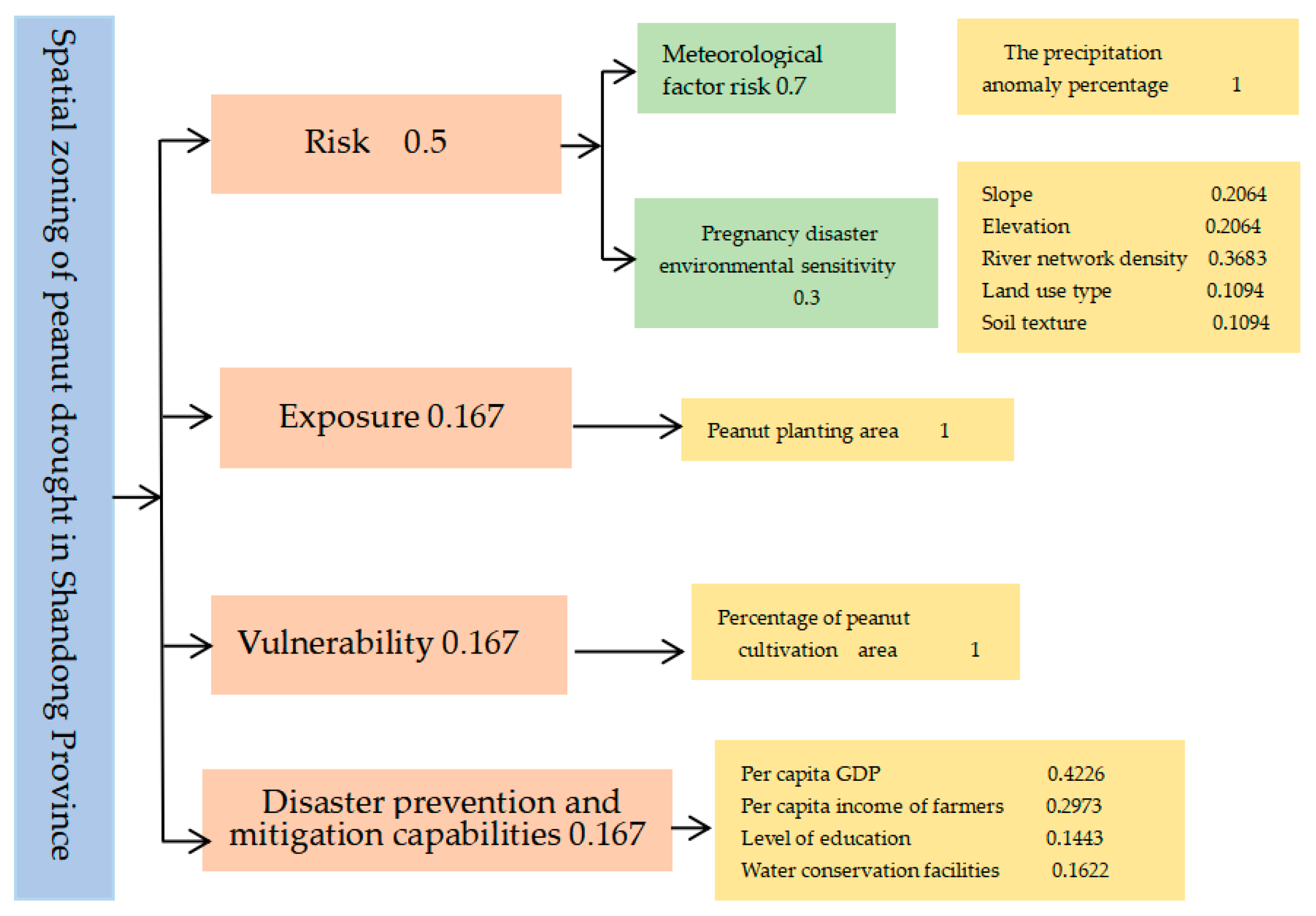
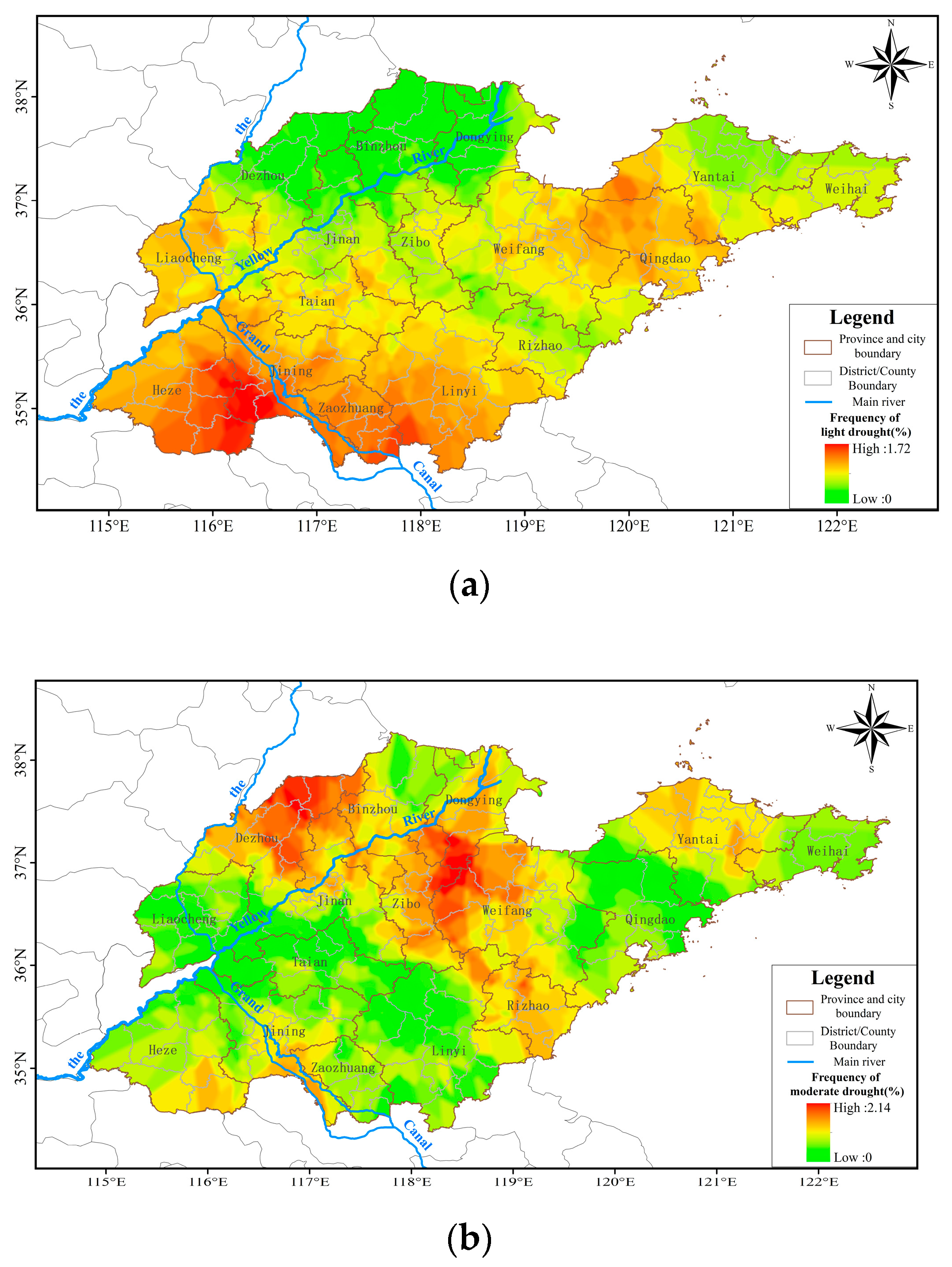




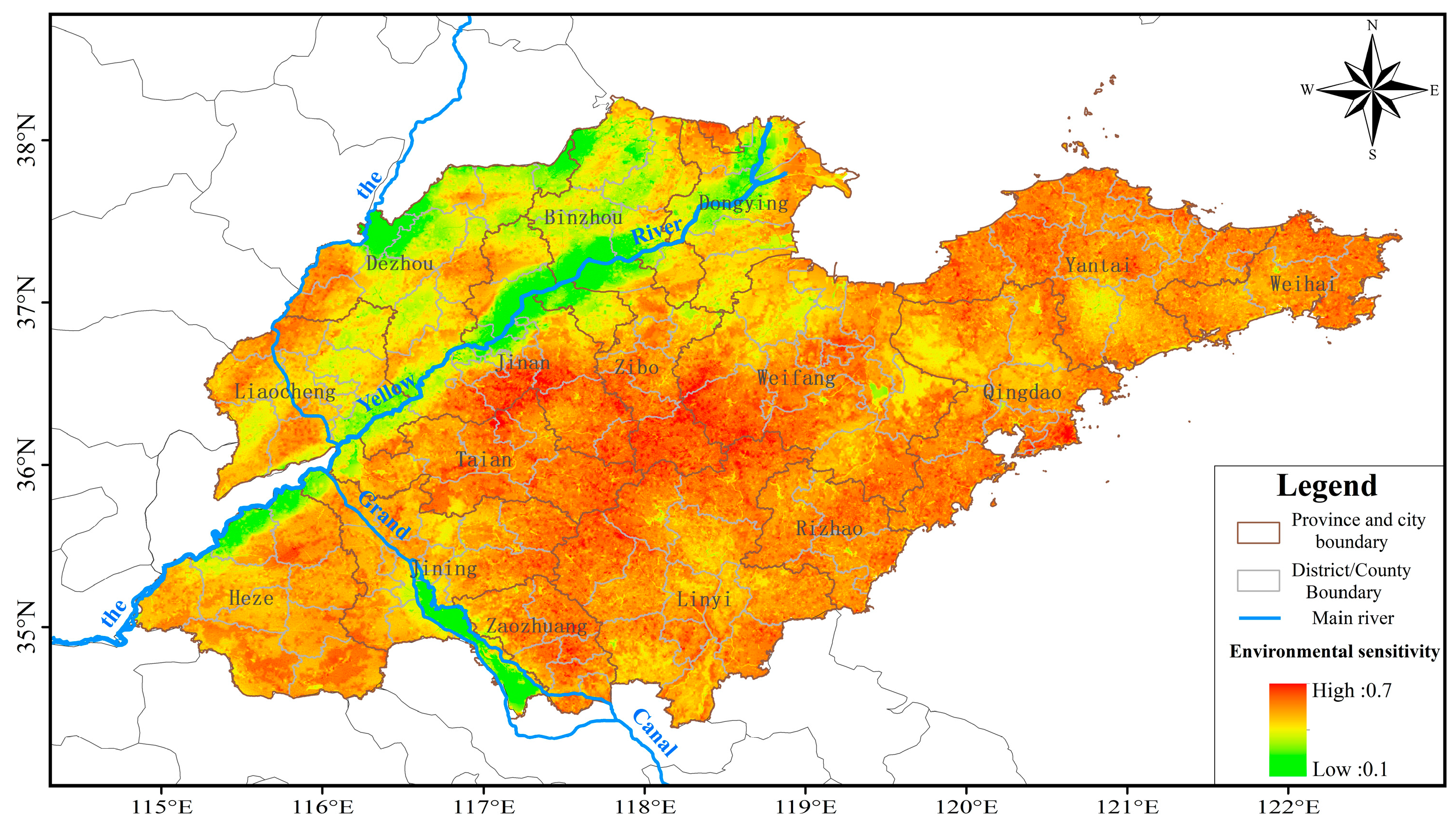

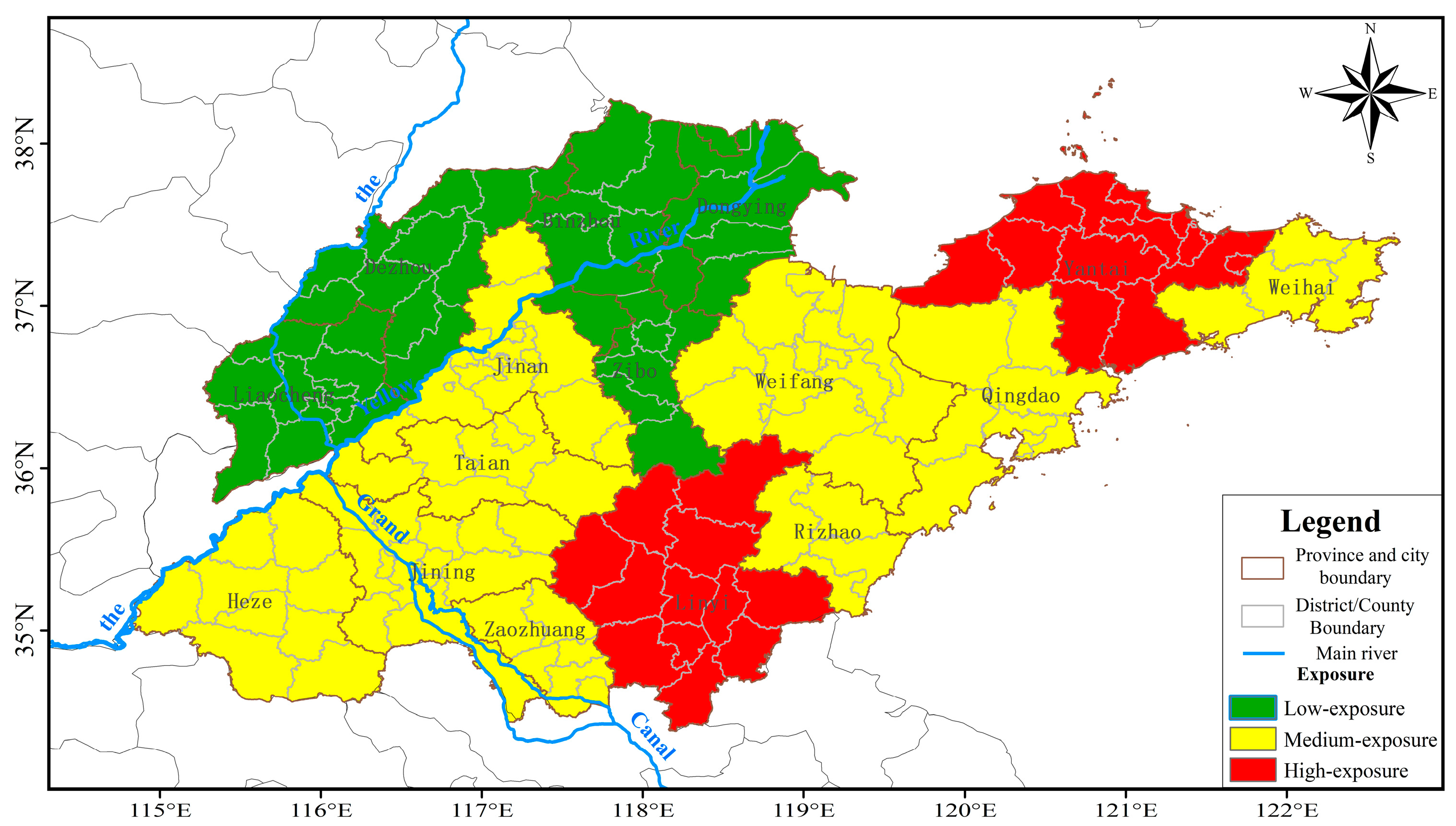

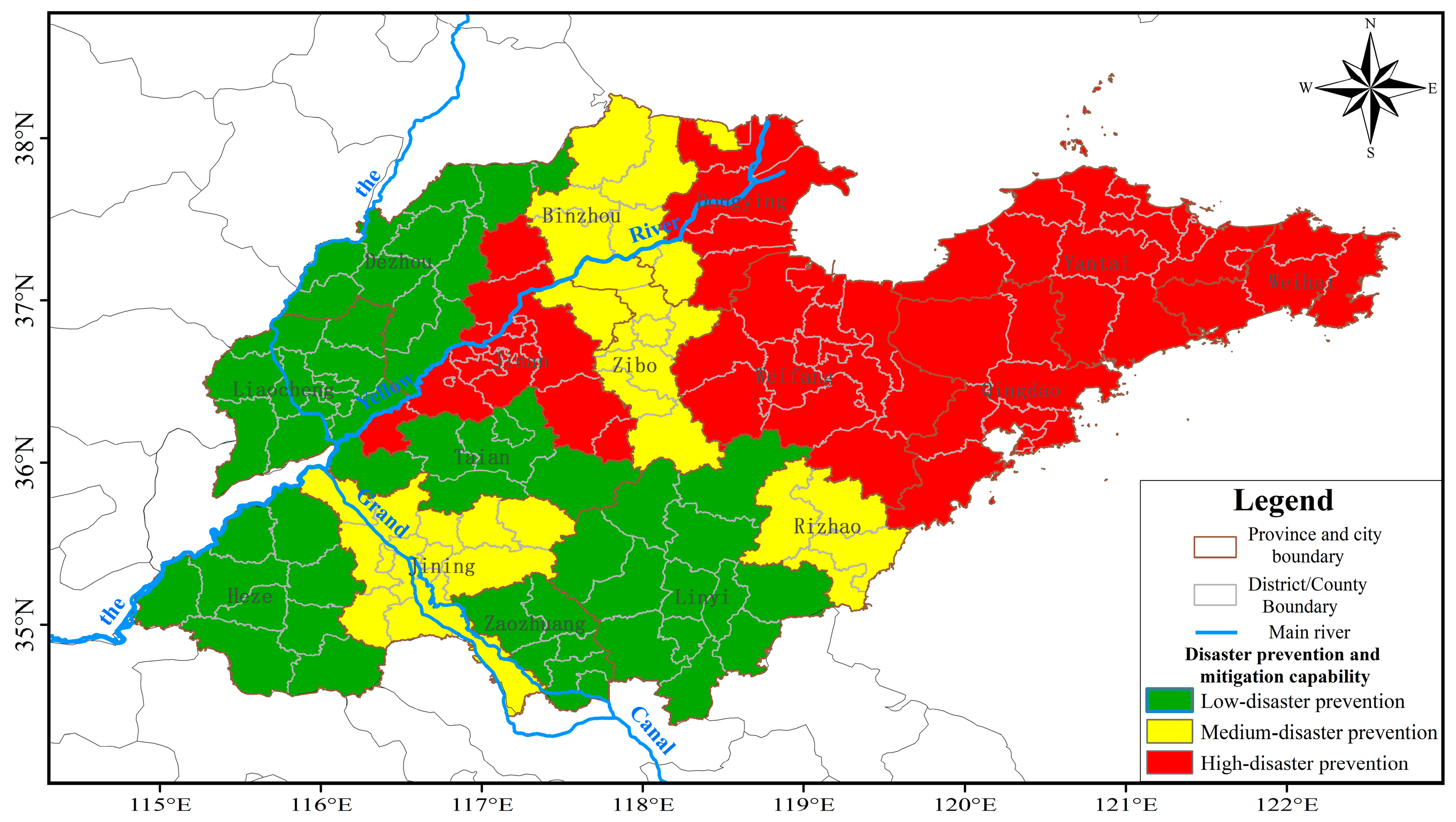
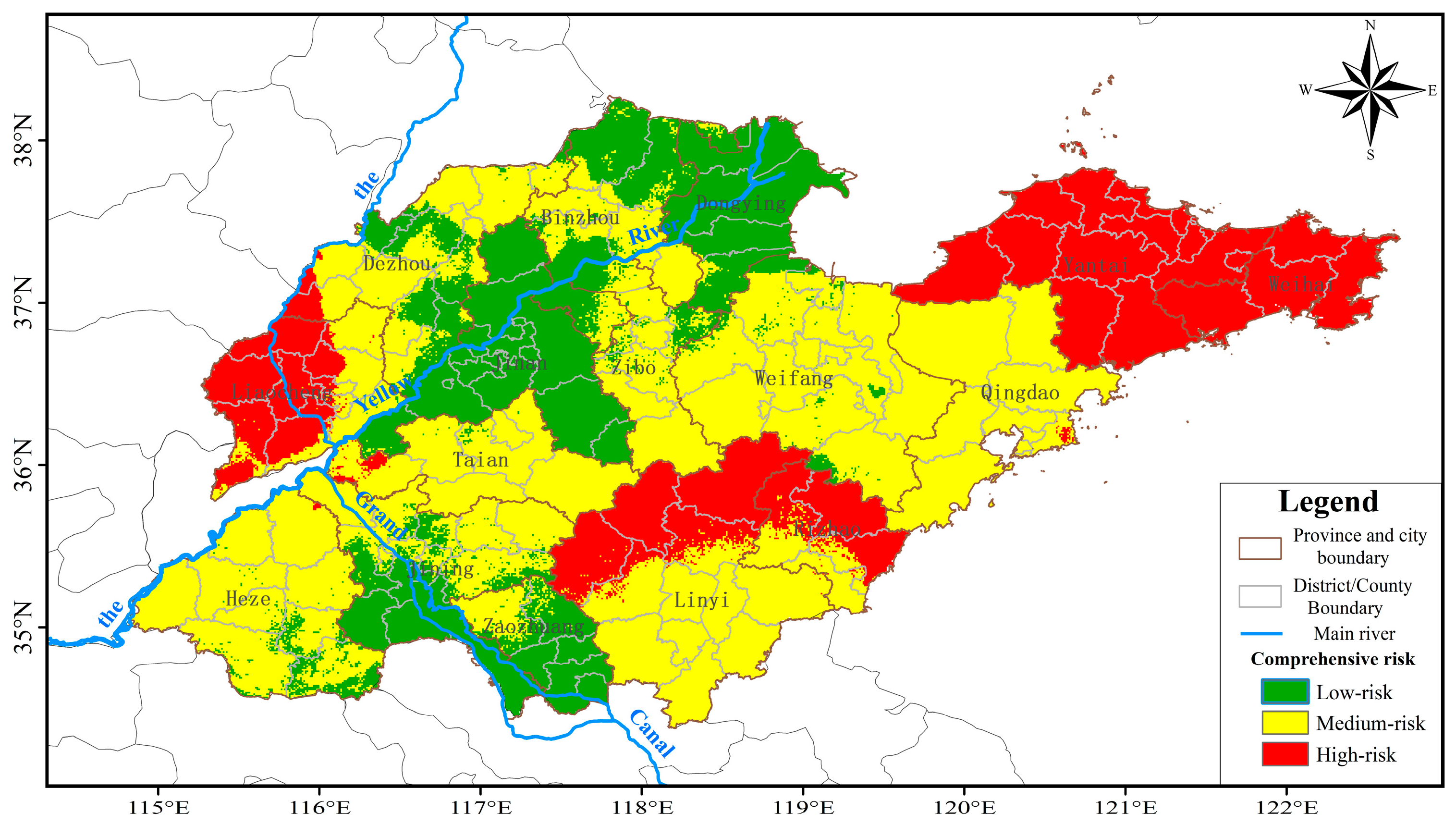
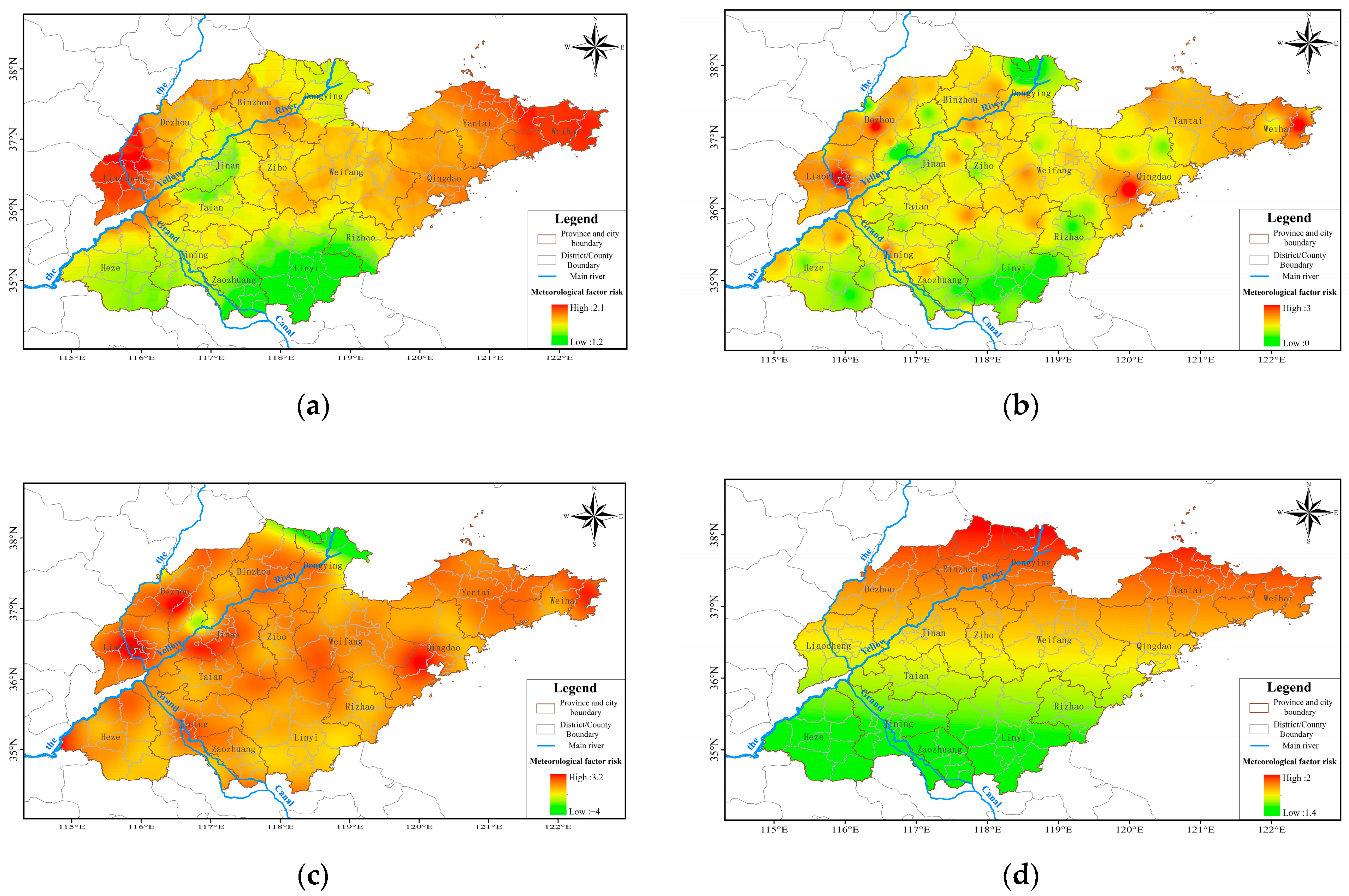
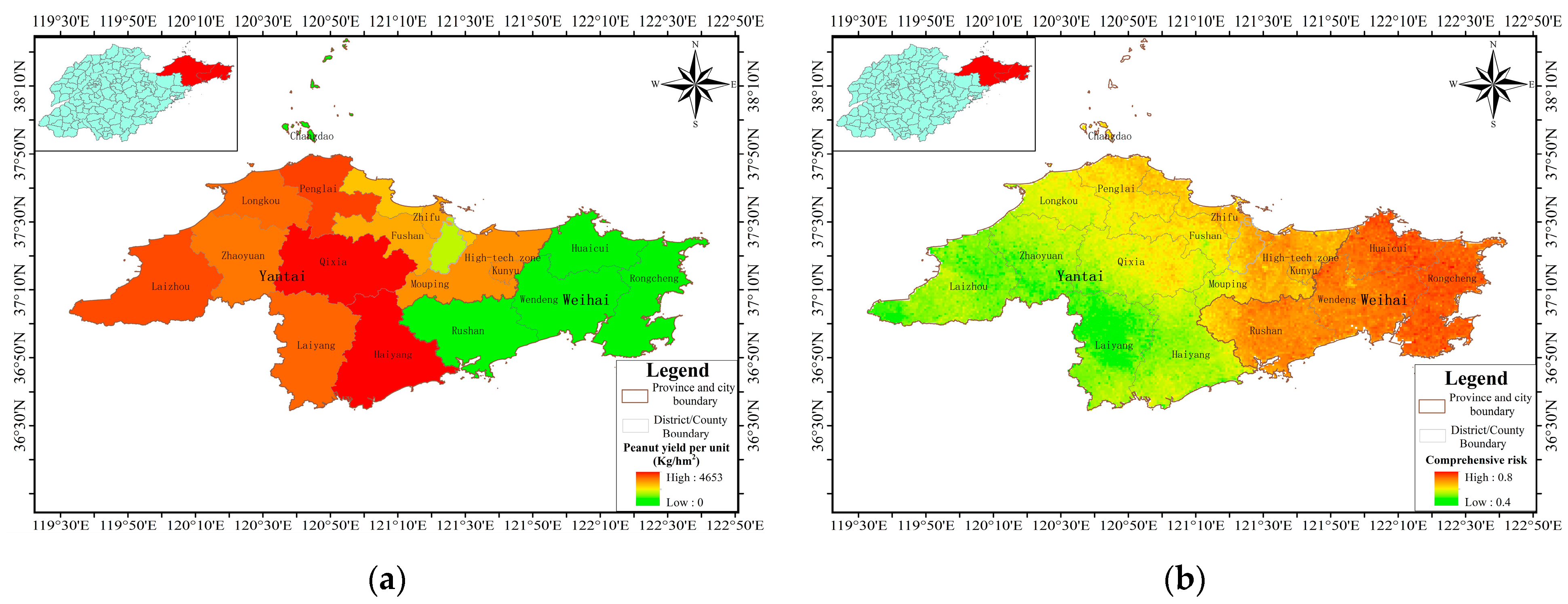
| Scale bij | Definition |
|---|---|
| 1 | The i factor is as important as the j factor. |
| 3 | The i factor is slightly more important than the j factor. |
| 5 | The i factor is more important than the j factor. |
| 7 | The i factor is much more important than the j factor. |
| 9 | The i factor is absolutely more important than the j factor. |
| 2, 4, 6, 8 | Between the noted levels. |
| M | 1 | 2 | 3 | 4 | 5 | 6 | 7 | 8 | 9 | 10 | 11 |
|---|---|---|---|---|---|---|---|---|---|---|---|
| RI | 0.00 | 0.00 | 0.58 | 0.90 | 1.12 | 1.24 | 1.32 | 1.41 | 1.45 | 1.49 | 1.51 |
| I | II | III | IV | V | Weight (W) | Matrix Product (AW) | AW/W | λmax | CI | CR | |
|---|---|---|---|---|---|---|---|---|---|---|---|
| I | 1 | 2 | 2 | 3 | 3 | 0.368 | 1.851 | 5.03 | 5.013 | 0.009 | 0.003 |
| II | 1/2 | 1 | 1 | 2 | 2 | 0.206 | 1.035 | 5.02 | CI = (λ − n)/n − 1 RI = 1.12 CR = CI/RI | ||
| III | 1/2 | 1 | 1 | 2 | 2 | 0.206 | 1.035 | 5.02 | |||
| IV | 1/3 | 1/2 | 1/2 | 1 | 1 | 0.109 | 0.548 | 5.03 | |||
| V | 1/3 | 1/2 | 1/2 | 1 | 1 | 0.109 | 0.548 | 5.03 | |||
| 25.13 | |||||||||||
| Level | Types | The Precipitation Anomaly Percentage Pa (%) | ||
|---|---|---|---|---|
| Monthly Scale | Quarterly Scale | Annual Scale | ||
| 1 | Drought-free | −40 < Pa | −25 < Pa | −15 < Pa |
| 2 | Light drought | −60 < Pa ≤ −40 | −50 < Pa ≤ −25 | −30 < Pa ≤ −15 |
| 3 | Moderate drought | −80 < Pa ≤ −60 | −70 < Pa ≤ −50 | −40 < Pa ≤ −30 |
| 4 | Severe drought | −95 < Pa ≤ −80 | −80 < Pa ≤ −70 | −45 < Pa ≤ −40 |
| 5 | Exceptional drought | Pa ≤ −95 | Pa ≤ −80 | Pa ≤ −45 |
| Land Use Type | Arable land | Woodland | Grassland | Waters | Construction Land | Unused Land |
|---|---|---|---|---|---|---|
| Score | 4 | 2 | 3 | 1 | 5 | 6 |
| Soil Texture | Overall Score | Soil Texture | Overall Score |
|---|---|---|---|
| Clay | 1 | Clay loam | 2 |
| Chalky loam | 5 | Loam | 4 |
| Sandy clay loam | 3 | Sandy loam | 6 |
| Loamy sand | 6 | Sand | 7 |
| Low-Risk Area | Medium-Risk Area | High-Risk Area | ||||
|---|---|---|---|---|---|---|
| Area (km2) | Ratio (%) | Area (km2) | Ratio (%) | Area (km2) | Ratio (%) | |
| Binzhou | 5098.2 | 53.1 | 4498.6 | 46.9 | 0 | 0 |
| Dezhou | 3104.1 | 29.3 | 6953.8 | 65.6 | 541.1 | 5.1 |
| Dongying | 7082.6 | 98.1 | 135.8 | 1.9 | 0.0 | 0.0 |
| Heze | 1178.3 | 9.7 | 10,921.3 | 90.1 | 18.3 | 0.2 |
| Jinan | 10,330.0 | 98.9 | 110.3 | 1.1 | 0.0 | 0.0 |
| Jining | 5342.9 | 47.6 | 5862.8 | 52.2 | 16.3 | 0.1 |
| Liaocheng | 18.3 | 0.2 | 3003.9 | 34.3 | 5737.3 | 65.5 |
| Linyi | 13.1 | 0.1 | 10,004.1 | 58.2 | 7173.1 | 41.7 |
| Qingdao | 1.0 | 0.0 | 11,068.9 | 98.9 | 121.7 | 1.1 |
| Rizhao | 9.1 | 0.2 | 1940.8 | 36.3 | 3392.6 | 63.5 |
| Taian | 147.6 | 1.9 | 7484.3 | 95.4 | 214.4 | 2.7 |
| Weihai | 0.0 | 0.0 | 0.0 | 0.0 | 5714.6 | 100.0 |
| Weifang | 887.0 | 5.5 | 15,168.6 | 94.4 | 12.2 | 0.1 |
| Yantai | 0.0 | 0.0 | 15.3 | 0.1 | 13,961.3 | 99.9 |
| Zaozhuang | 3345.6 | 73.8 | 1175.7 | 26.0 | 9.1 | 0.2 |
| Zibo | 1076.9 | 17.7 | 5005.8 | 82.3 | 3.0 | 0.0 |
Publisher’s Note: MDPI stays neutral with regard to jurisdictional claims in published maps and institutional affiliations. |
© 2022 by the authors. Licensee MDPI, Basel, Switzerland. This article is an open access article distributed under the terms and conditions of the Creative Commons Attribution (CC BY) license (https://creativecommons.org/licenses/by/4.0/).
Share and Cite
Jiang, M.; Xue, X.; Zhang, L.; Chen, Y.; Zhao, C.; Song, H.; Wang, N. Peanut Drought Risk Zoning in Shandong Province, China. Sustainability 2022, 14, 3322. https://doi.org/10.3390/su14063322
Jiang M, Xue X, Zhang L, Chen Y, Zhao C, Song H, Wang N. Peanut Drought Risk Zoning in Shandong Province, China. Sustainability. 2022; 14(6):3322. https://doi.org/10.3390/su14063322
Chicago/Turabian StyleJiang, Meiyi, Xiaoping Xue, Lijuan Zhang, Yuying Chen, Cheng Zhao, Haiyan Song, and Nan Wang. 2022. "Peanut Drought Risk Zoning in Shandong Province, China" Sustainability 14, no. 6: 3322. https://doi.org/10.3390/su14063322
APA StyleJiang, M., Xue, X., Zhang, L., Chen, Y., Zhao, C., Song, H., & Wang, N. (2022). Peanut Drought Risk Zoning in Shandong Province, China. Sustainability, 14(6), 3322. https://doi.org/10.3390/su14063322






